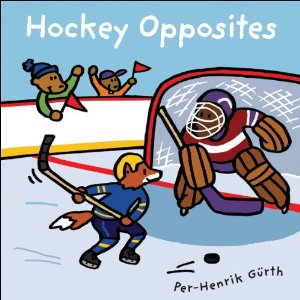Sure enough, I had another suggestion for things kids can learn from hockey. Opposites! That idea is pretty obvious. Here are a few: cold-hot, up-down, in-out, win-lose, behind-in front, happy-sad, black-white, big-little, go-stop,  and I’m sure there are more.
and I’m sure there are more.
Opposites are not easy to get right, but they are an important language and thinking skill. Some of them are easy to learn, such as hot and cold, and some are much harder, for instance little and big. A hockey puck is little and a hockey goalie net is big. Or is it? That same net looks pretty small in a big arena. Opposite words can be tricky and confusing. Lots of practice and repetition is needed to figure out opposites, but that helps with readiness for kindergarten. (This book Hockey Opposites is written by PerHenrick Gurth.)
Kindergarten readiness evaluations vary a great deal, but generally, kids will be able to correctly name simple opposites: cold and ___, or up and ____. Since kids learn best when they are interested, if hockey appeals to them, by all means let the fun of hockey help them learn. Onto Game 4 of the Stanley Cup Finals. Go, hockey, go.
